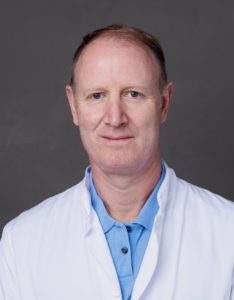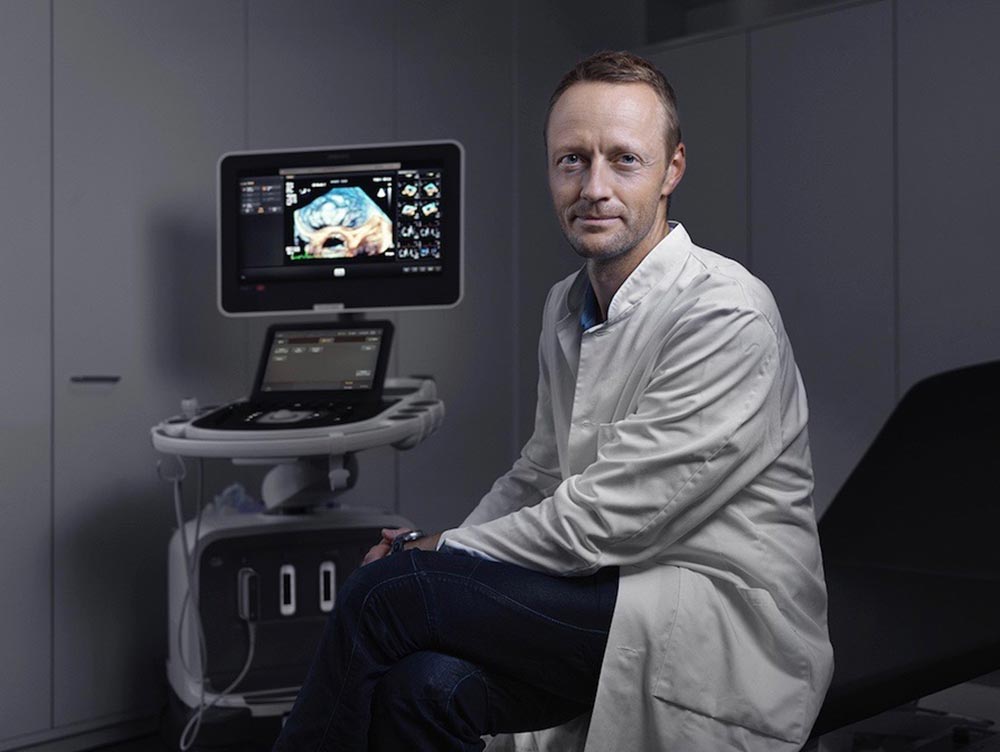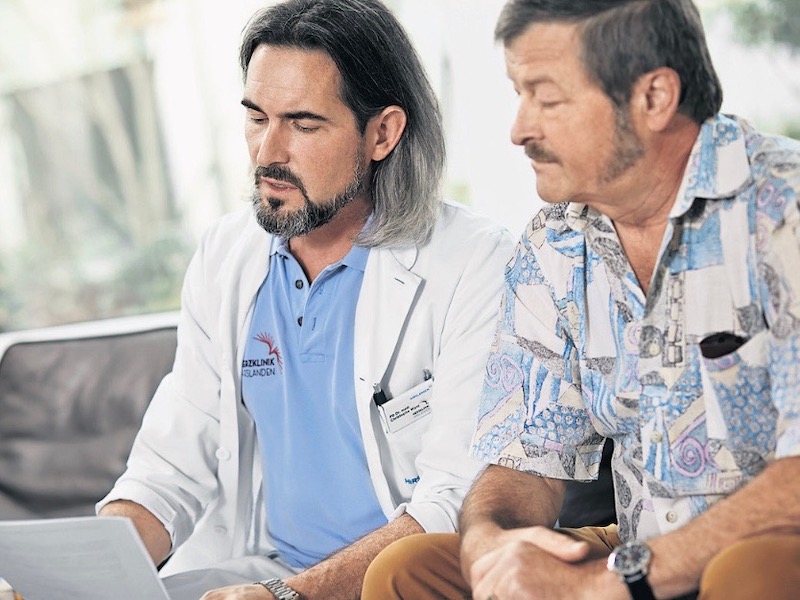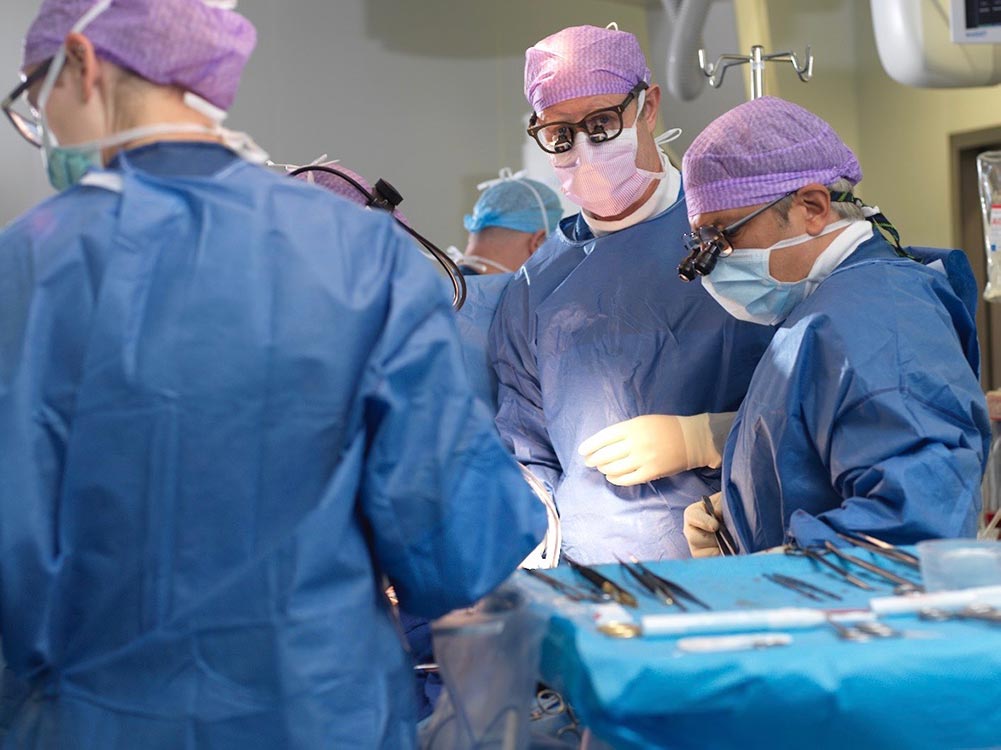TAVI catheter for aortic valve replacement
19 August 2014
Aortic valve replacement: surgical orcatheter-based using TAVI
Once developed for high-risk patients, this method of aortic valve replacement is increasingly being used for lower-risk patients. Weighing up open surgery versus TAVI, a precise definition of the possible access routes and exact planning of the procedure serve to ensure the highest possible safety.

Prof. Dr. med. Jürg Grünenfelder - Specialist Cardiac and Thoracic Vascular Surgery - HerzKlinik Hirslanden
Prof. Grünenfelder (Cardiac Surgery) and Prof. Corti (Interventional Cardiology) explain TAVI intervention
Surgical aortic valve replacement is the treatment of choice for high-grade aortic valve stenosis. In open surgery, the sternum is cut along its longitudinal axis, thus opening the chest; the minimally invasive approach is performed through a small lateral opening of the chest or a partial cutting of the sternum in the upper third. In all three approaches, a heart-lung machine is used to operate on the calcified aortic valve. The defective valve is removed and subsequently replaced by a biological or mechanical valve prosthesis. The results of open or minimally invasive surgical aortic valve replacement are very well documented and today show a very low mortality rate of only 2 to 4% for all patients with aortic stenosis.1 Symptoms such as chest pain and tightness, weakness, shortness of breath and even fainting on exertion usually disappear.
TAVI as an alternative for high-risk patients

Prof. Dr. med. Roberto Corti - Medical Director - Interventional Cardiology - HerzKlinik Hirslanden
For elderly, chronically ill patients and weakened patients with multiple diseases, such an operation was associated with too high a risk. In order to be able to treat these high-risk patients as well, a catheter-based method was developed as an alternative to open surgery, which is used by cardiologists. This catheter-based aortic valve replacement (transcatheter aortic valve implantation), or TAVI for short, is now increasingly being performed in lower-risk patients because of the good results and the gentle procedure.
3D planning of the valve intervention
In order to be able to perform a TAVI with the greatest possible safety, meticulous planning of the intervention is required. For this reason, a computer tomography of the aortic valve and especially of the vessels - from the aorta to the inguinal vessels - is performed in all patients. These images are then used to produce a 3D reconstruction of the valve and vasculature and their spatial arrangement in the body (Fig. 3). The size of the vessels and the aortic valve is also measured in order to select the appropriate valve for the patient in advance (Fig. 4). The most suitable access route to the aortic valve is then determined on the basis of this 3D representation and the measurements, paying attention to the size, severe calcifications and a tortuous course of the vessels.
Positioning of the aortic valve
The valve can be inserted by catheter into the diseased aortic valve via four access routes: via the groin (transfemoral) in 80 to 90 % and alternatively in 10 to 20 % of cases directly via the apex of the heart (transapical), via the subclavian artery (trans-subclavian) or directly via the ascending aorta (transaortic). Both the transapical and transaortic approaches require a small opening of the chest between the ribs. The alternative approaches are chosen if the inguinal vessels are either too small, too calcified or too tortuous.
Under X-ray control, the new valve is then placed precisely at the level of the endogenous aortic valve ring (Fig. 1). The catheter is then removed and the access route closed. In contrast to open surgery, the aortic valve is not removed but merely pressed against the heart wall by the TAVI valve (Fig. 2). A heart-lung machine is not necessary for this intervention.
Catherter-based TAVI or minimally invasive aortic valve surgery?
The results achieved with a TAVI aortic valve replacement can also be described as good in view of the symptoms. The risk of death from the operation within 30 days is 3 to 5% worldwide.2 How long this valve will remain functional is still unclear, as long-term results are lacking. However, there is no evidence to date that it should last less than conventional bioprostheses. However, a higher rate of pacemaker implantation must be expected with TAVI compared to open surgery.
Therefore, to determine the optimal approach for a patient with aortic valve disease, both therapeutic options should be discussed impartially in an interdisciplinary conference of cardiac surgeons and interventional cardiologists.
Since TAVI is an expensive procedure that currently provides a proven benefit only to certain patients, it is important that there is an honest balancing of interests when selecting therapeutic procedures. This should result in TAVI being chosen not only because the procedure is gentler, but also because it will benefit the patient in the longer term.
TAVI is indicated in so-called high-risk patients who are either over 80 years old and have additional risk factors such as renal insufficiency or who have had previous heart surgery. Patients with an intermediate surgical risk may be recommended either TAVI or open surgery. On the other hand, in a low-risk patient, such as a patient under 70 years of age who is otherwise healthy, conventional surgery should continue to be considered the standard of care.
1 Brown JM et al, Ann Thorac Surg 2009;137:82-90, Plass AR et al, Ann Thorac Surg. 2009 Dec;. 88 (6): 1851-6, Lamelas J et al, Ann Thorac Surg. 2011 Jan;91(1):79-84; 2 Wenaweser P et al, EuroIntervention 2014.
More reports
Cardiac Imaging (Heart Imaging)
Techniques of imaging the heart (cardiac imaging): Imaging the heart (cardiac imaging) is indispensable for making a diagnosis....
HerzTeam: Experience is decisive
The experience of the heart team is crucial Stenosis and leakage of the heart valve are among the most common structural heart diseases. The...
Heart attack - Precious minutes
Every minute is precious in a heart attack The earlier a heart attack is treated, the higher the chance of survival and the...
Successful reconstruction of the tricuspid valve
Ernst Spalinger has confidence in his heart again. After the operation on the tricuspid valve, fear and shortness of breath are blown away....
Minimally invasive heart surgery
Prof. Dr. Jürg Grünenfelder, specialist in cardiac and thoracic vascular surgery at Herzklinik Hirslanden, is a specialist in minimally invasive...
Structural heart disease
What is structural heart disease? Structural heart disease refers to diseases of the heart that predominantly affect one of the four heart valves,...
All specialists at the Heart Valve Center of Herzklinik Hirslanden
Prof. Dr. med. ROBERTO CORTI
Interventional Cardiology
Prof. Dr. med. JÜRG GRÜNENFELDER
Cardiac Surgery
MD. THIERRY AYMARD
Cardiac Surgery
PD Dr. med. PATRIC BIAGGI
Cardiology | Imaging
Prof. Dr. med. OLIVER GÄMPERLI
Interventional Cardiology
PD Dr. med. DAVID HÜRLIMANN
Cardiology | Rhythmology
Dr. med. IOANNIS KAPOS
Cardiology | Imaging
MD. SILKE WÖRNER
Cardiology | Imaging
Prof. Dr. med. GEORG NOLL
Cardiology | Prevention
MD. IVANO REHO
Cardiology | Aortic Aneurysm
PD Dr. med. (H) DIANA RESER
Cardiac Surgery
Prof. Dr. med. JAN STEFFEL
Cardiology | Rhythmology
Prof. Dr. med. PETER M. WENAWESER
Interventional Cardiology
Prof. Dr. med. CHRISTOPHE WYSS
Interventional Cardiology





